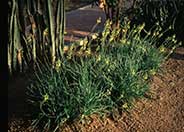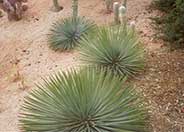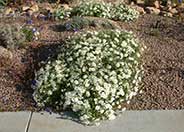
Common name:Pygmy Date Palm, Roebelin Palm
Botanical name:Phoenix roebelenii
This tree will grow to about 10' tall and has dark green, spiny petiole foliage. It does well in full sun to heavy shade; it likes moderate to heavy irrigation, but can take periods of dryness.

Common name:Sundrops
Botanical name:Calylophus hartwegii
This low-growing perennial grows 1' tall and 3' tall; it has woody stems with bright green leaves. It produces large, lemon yellow flowers that are up to 4" across and bloom spring through summer and possibly through fall, depending on weather conditions.
Maintenance Tips
Calylophus hartwegii is a soft-textured, low-growing perennial with bright yellow flowers. It only grows 12" tall and up to 3' wide. It is very fast growing in the late winter and early spring, and then it is covered with flowers from mid-spring until fall if the weather is ideal. In the fall, when the days start to get shorter and the rains begin, this plant can decline. The root system will stay intact, but the flowering stops, and the foliage will completely die back. This plant benefits from hard pruning, taking the foliage, and branching almost down to the ground. Don't expect any new growth to emerge until the days start to get longer and warm up. The foliage will start to emerge, and the plant's quick growth and blooming cycle will return.
Common name:Yellow Stalked Bulbine
Botanical name:Bulbine frutescens
Bulbine frutescens is an evergreen perennial that grows 1.5' tall and wide. The leaves are narrow and long. This low-spreading plant is attractive year round.
Maintenance Tips
Bulbine frutescens is a grass-like succulent that has a very dense form that can grow 18" tall and wide. It can bloom throughout the year and is very attractive to hummingbirds, bees, and butterflies. To keep this plant low maintenance, plant it in full sun with excellent drainage. Rock gardens are a perfect location. The plant is drought tolerant once established but will require some supplemental soil as it is rooting. This plant can spread from underground roots, so it can be invasive if it is happy in the environment. There is very little maintenance required to keep it looking and performing its best, but it should be divided every couple of years to invigorate it. If the plant looks dull and discolored, there is a good chance it is going into its drought mode, so some supplemental water will kick start it again.
Common name:Our Lord's Candle
Botanical name:Hesperoyucca whipplei
Stemless, it produces dense clusters of rigid, gray green leaves 12"-18" long. Its drooping, bell-shaped flowers appear on large, branched spikes 3'-6' long. Plants die after blooming, much like Agaves, but only individual rosettes will die off; others in clump will continue to live and eventually bloom. Overall plant grows 3' tall and 6' wide. This CA native prefers well drained soil and is drought tolerant but will lose lower leaves with extended drought..

Common name:Woolly Blue Curls
Botanical name:Trichostema lanatum
The Woolly Blue Curls is an evergreen shrub that reaches 3'-5' high. It has an open branching habit and has long stalks of brilliant purple woolly flowers in the spring and summer. This shrub is native to California, is drought tolerant, and attracts hummingbirds.

Common name:Catmint
Botanical name:Nepeta X faassenii
Nepeta faassenii makes soft, gray green, undulating mounds that are 1.5' high when blooming. The small leaves are attractive to cats. This perennial has lavender blue flowers in late spring and early summer.

Common name:Mexican Palo Verde, Jerusalem Thorn
Botanical name:Parkinsonia aculeata
The Mexican Palo Verde has prickly stems. This tree is very fast growing with sparse foliage and very long narrow leaves. Yellow flowers with orange red throats bloom sporadically. It is very messy, thorny, weedy and short-lived. This tree is usually found on limestone soils in areas with moisture but is strongly drought tolerant. It can withstand saline conditions. It can be cold or drought deciduous. It is beautiful in form being light and airy looking, with green bark.

Common name:Blackfoot Daisy
Botanical name:Melampodium leucanthum
Small mounding perennial grows quickly to 1' x 2'. White daisylike flowers with yellow centers cover the plant nearly year-round The leaves are narrow and gray-green. Accepts full sun or partial shade but blooms better in the sun. Bright and colorful groundcover. Plant in well-drained soil. Native to the southwest U.S. and Mexico.
Maintenance Tips
Melampodium leucanthum or the Blackfoot Daisy, is a small herbaceous perennial that reaches 12 – 18" tall and wide. It is very drought and heat-tolerant and requires very little maintenance to look and perform its best. Once the plant is established, it requires very little water, but it does tend to have a much longer blooming cycle if it is offered supplemental water during the spring and summer. It is very attractive to birds, butterflies, and bees and is usually pest-free. As an herbaceous perennial, it can be attractive to aphids and other soft-bodied insects that can damage the foliage. Instead of using pesticides to control these pests, it would be better to use a hard jet of water or even bring in ladybugs to treat the infestation. That will ensure the beneficial insects and birds can continue to enjoy the flowers.Designer: Susan Triindle
Photographer: GardenSoft